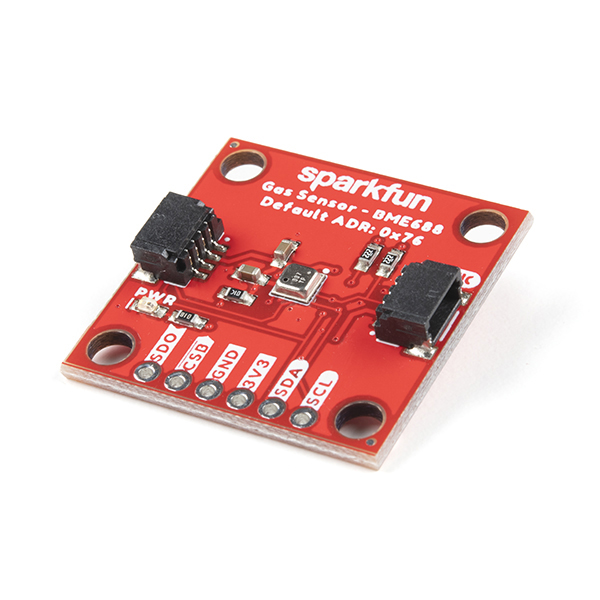SparkFun Environmental Sensor - BME688 (Qwiic)
The SparkFun BME688 Environmental Sensor is a breakout that combines a gas scanning sensor with temperature, humidity, and barometric pressure sensing for a complete environmental sensor in a single package. The gas sensor on the BME688 can detect a wide variety of volatile organic compounds (VOCs), volatile sulfur compounds (VSCs), and other gases such as carbon monoxide and hydrogen in the part per billion (ppb) range. Combine that with precise temperature, humidity, and barometric pressure and the BME688 can work as a completely standalone environmental sensor all in a 1in. x 1in. breakout!
The sensor communicates via either I2C or SPI. We've broken out the I2C pins to our Qwiic system so no soldering is required to connect it to the rest of your system but if you would prefer, both the I2C and SPI pins are also broken out to standard 0.1in.-spaced pins.
Note: While this sensor can be used with the BME AI-Studio and BSEC2 Arduino library; it is recommended for the AI functionality, users purchase the BME688 Evaluation Board (Coming Soon) for ease of use.
Important: In order to avoid contamination of its gas scanning capabilities, DO NOT touch the metallic casing of the BME688 sensor. Please, handle with care.
The SparkFun Qwiic connect system is an ecosystem of I2C sensors, actuators, shields and cables that make prototyping faster and less prone to error. All Qwiic-enabled boards use a common 1mm pitch, 4-pin JST connector. This reduces the amount of required PCB space, and polarized connections mean you can’t hook it up wrong.
- Uses I2C interface (Qwiic-enabled)
- I2C Addresses: 0x76 (Default) or 0x77
- 2x Qwiic Connectors
- Operating voltage range
- 1.71V - 3.6V
- Typically 3.3V if using the Qwiic cable
- Relative humidity
- Operating range: 0% to 100%
- Absolute Accuracy: ±3%RH
- Resolution: ±0.008%RH
- Temperature
- Operating range: -40°C to +85 °C
- Absolute Accuracy: ±1.0°C
- Resolution: 0.01°C
- Pressure
- Operating range: 300hPa - 1100hPa
- Absolute accuracy: ±60Pa (0°C to 65°C)
- Resolution: 0.18PA, highest oversampling
- Gas
- F1 score for H₂S scanning: 0.92
- Standard scan speed: 10.8 sec/scan
- Sensor-to-sensor deviation: ± 15% ± 15
- Typical current consumption (varies based on mode and active sensor)
- 2.1 µA to 18mA
- 0.15 µA (sleep mode)
- 3.9 mA in standard gas scan mode
- Schematic
- Eagle Files
- Hookup Guide
- Datasheet (BME688)
- BME AI-Studio Manual
- BME680 Arduino Library
- Bosch Software Page:
- BME AI-Studio (Mac/Windows) (Download from software page)
- BME68x Arduino Library
- BME68x API
- BSEC2 Arduino Library
- BSEC2 API (Download from software page)
- BSEC2 Integration Guide
- Qwiic Connect System
- GitHub Hardware Repo
- Board Dimensions
SparkFun Environmental Sensor - BME688 (Qwiic) Product Help and Resources
SparkFun Environmental Sensor Breakout - BME68x (Qwiic) Hookup Guide
May 14, 2020
A hookup guide to get started with the BME68x Environmental Sensor from Bosch. Monitor the air quality, temperature, humidity, and barometric pressure with this Qwiic sensor!
Core Skill: Programming
If a board needs code or communicates somehow, you're going to need to know how to program or interface with it. The programming skill is all about communication and code.
Skill Level: Rookie - You will need a better fundamental understand of what code is, and how it works. You will be using beginner-level software and development tools like Arduino. You will be dealing directly with code, but numerous examples and libraries are available. Sensors or shields will communicate with serial or TTL.
See all skill levels
Core Skill: Electrical Prototyping
If it requires power, you need to know how much, what all the pins do, and how to hook it up. You may need to reference datasheets, schematics, and know the ins and outs of electronics.
Skill Level: Rookie - You may be required to know a bit more about the component, such as orientation, or how to hook it up, in addition to power requirements. You will need to understand polarized components.
See all skill levels
Comments
Looking for answers to technical questions?
We welcome your comments and suggestions below. However, if you are looking for solutions to technical questions please see our Technical Assistance page.
Customer Reviews
No reviews yet.




